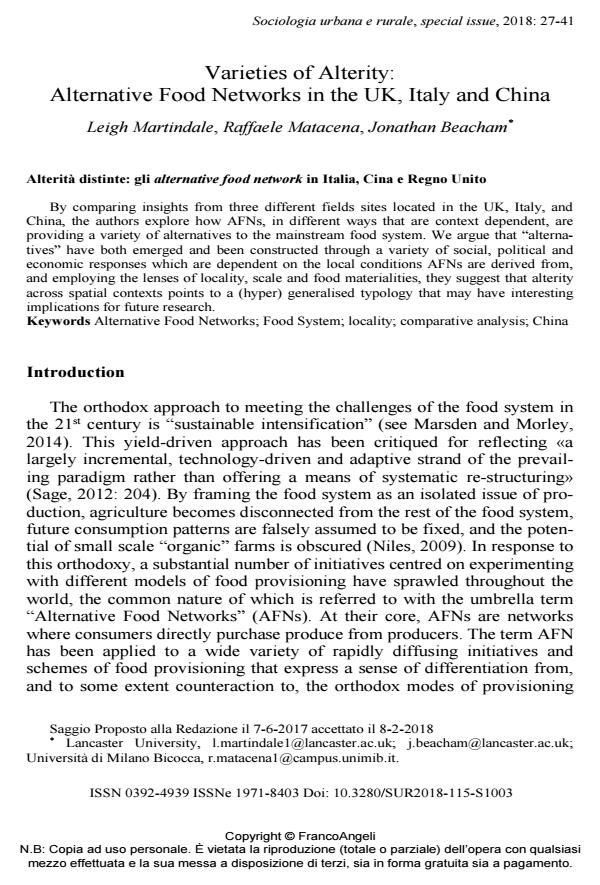Varieties of Alterity: Alternative Food Networks in the UK, Italy and China
Titolo Rivista SOCIOLOGIA URBANA E RURALE
Autori/Curatori Leigh Martindale, Raffaele Matacena, Jonathan Beacham
Anno di pubblicazione 2018 Fascicolo 2018/115suppl.
Lingua Inglese Numero pagine 15 P. 27-41 Dimensione file 1113 KB
DOI 10.3280/SUR2018-115-S1003
Il DOI è il codice a barre della proprietà intellettuale: per saperne di più
clicca qui
Qui sotto puoi vedere in anteprima la prima pagina di questo articolo.
Se questo articolo ti interessa, lo puoi acquistare (e scaricare in formato pdf) seguendo le facili indicazioni per acquistare il download credit. Acquista Download Credits per scaricare questo Articolo in formato PDF

FrancoAngeli è membro della Publishers International Linking Association, Inc (PILA)associazione indipendente e non profit per facilitare (attraverso i servizi tecnologici implementati da CrossRef.org) l’accesso degli studiosi ai contenuti digitali nelle pubblicazioni professionali e scientifiche
By comparing insights from three different fields sites located in the UK, Italy, and China, the authors explore how AFNs, in different ways that are context dependent, are providing a variety of alternatives to the mainstream food system. We argue that "alternatives" have both emerged and been constructed through a variety of social, political and economic responses which are dependent on the local conditions AFNs are derived from, and employing the lenses of locality, scale and food materialities, they suggest that alterity across spatial contexts points to a (hyper) generalised typology that may have interesting implications f or future research.
Parole chiave:Alternative Food Networks; Food System; locality; comparative analysis; China
- The Palgrave Handbook of Global Social Problems Michele Filippo Fontefrancesco, pp.1 (ISBN:978-3-030-68127-2)
- Boosting Sustainable Innovation in Densely Populated Areas: A Milieux Innovateurs Approach Yari Vecchio, Felice Adinolfi, Claudia Albani, Luca Bartoli, Marcello De Rosa, in Sustainability /2020 pp.9131
DOI: 10.3390/su12219131 - Evolving local agrifood initiatives within a territorial agrifood system: the case of Prato Province, Italy Barbora Duží, David Fanfani, Stanislav Martinát, in Agroecology and Sustainable Food Systems /2023 pp.239
DOI: 10.1080/21683565.2022.2138673 - Rural Affective Economies Michele Filippo Fontefrancesco, pp.151 (ISBN:978-3-031-70825-1)
- Traditional food for a sustainable future? exploring vulnerabilities and strengths in Italy’s foodscape and short agrifood chains Michele Filippo Fontefrancesco, in Sustainable Earth Reviews 7/2023
DOI: 10.1186/s42055-023-00056-5 - Conventionalization of Alternative Agriculture and the Intervention of External Investors: Case Sharing Community-Supported Agriculture Farm, China Meiling Wu, in Sustainability /2024 pp.5088
DOI: 10.3390/su16125088 - A framework for assessing the contribution of alternative food initiatives to food system transformations towards sustainability Rebecca Laycock Pedersen, Kimberly A. Nicholas, in Agriculture and Human Values 17/2026
DOI: 10.1007/s10460-025-10807-z - Practices of Food Sovereignty in Italy and England: Short Food Supply Chains and the Promise of De‐Commodification Raffaele Matacena, Paolo Corvo, in Sociologia Ruralis /2020 pp.414
DOI: 10.1111/soru.12283 - ‘I will know it when I taste it’: trust, food materialities and social media in Chinese alternative food networks Leigh Martindale, in Agriculture and Human Values /2021 pp.365
DOI: 10.1007/s10460-020-10155-0
Leigh Martindale, Raffaele Matacena, Jonathan Beacham, Varieties of Alterity: Alternative Food Networks in the UK, Italy and China in "SOCIOLOGIA URBANA E RURALE" 115suppl./2018, pp 27-41, DOI: 10.3280/SUR2018-115-S1003